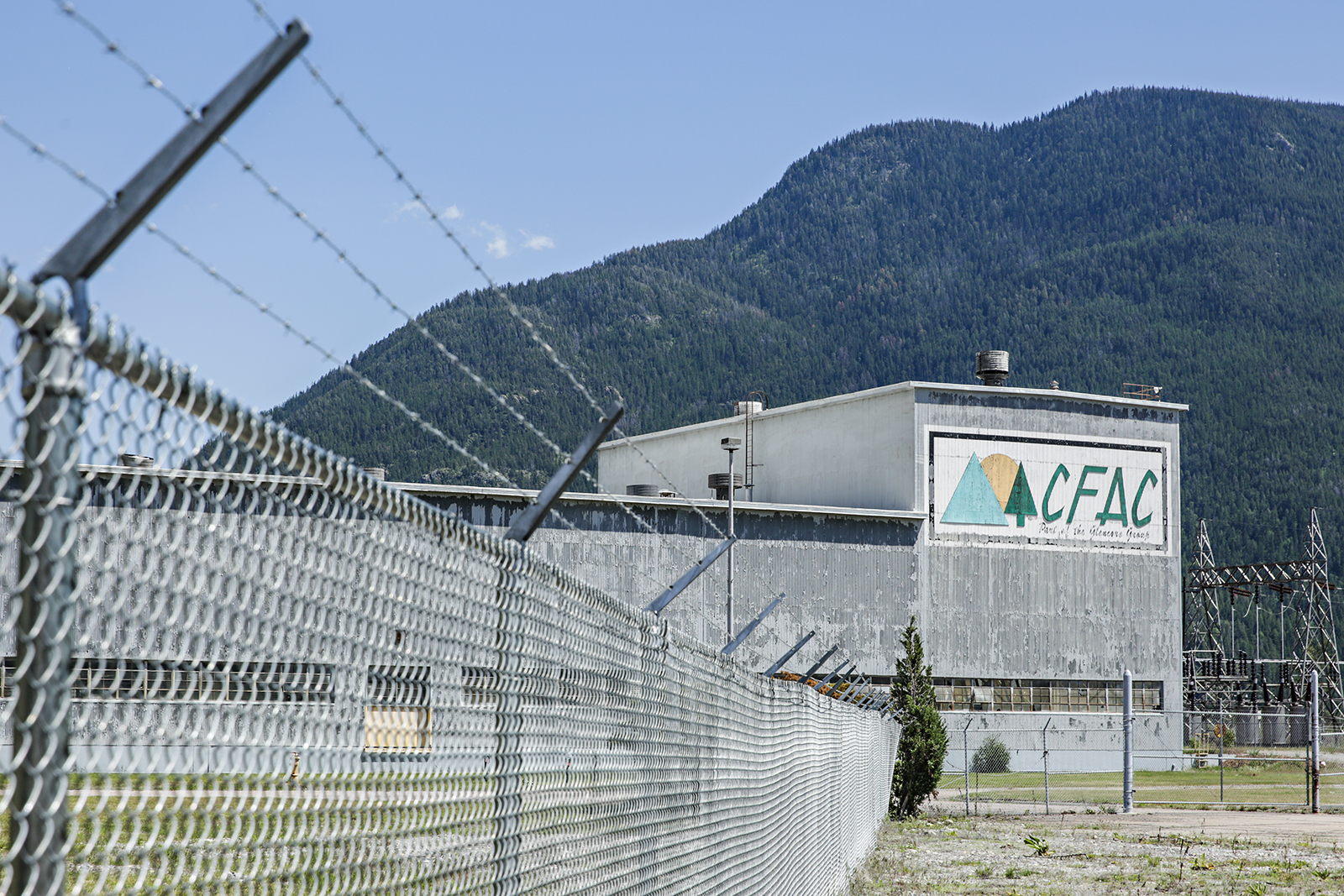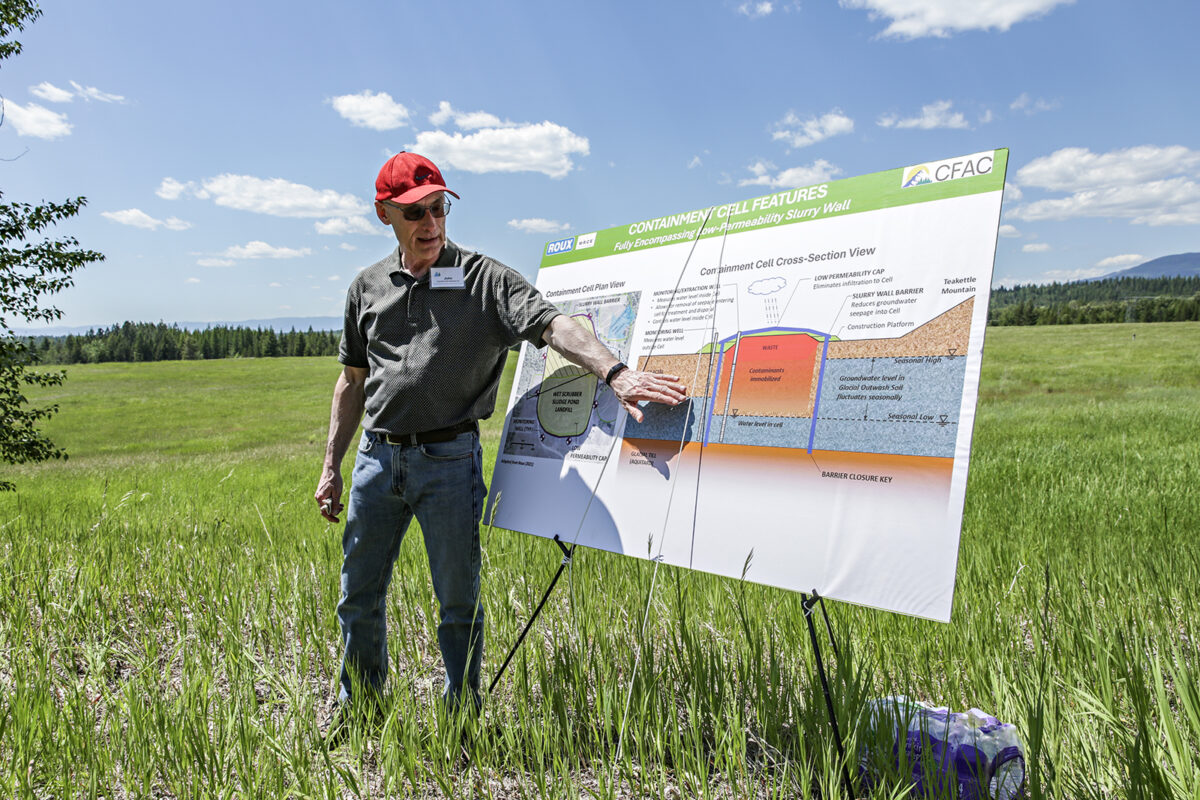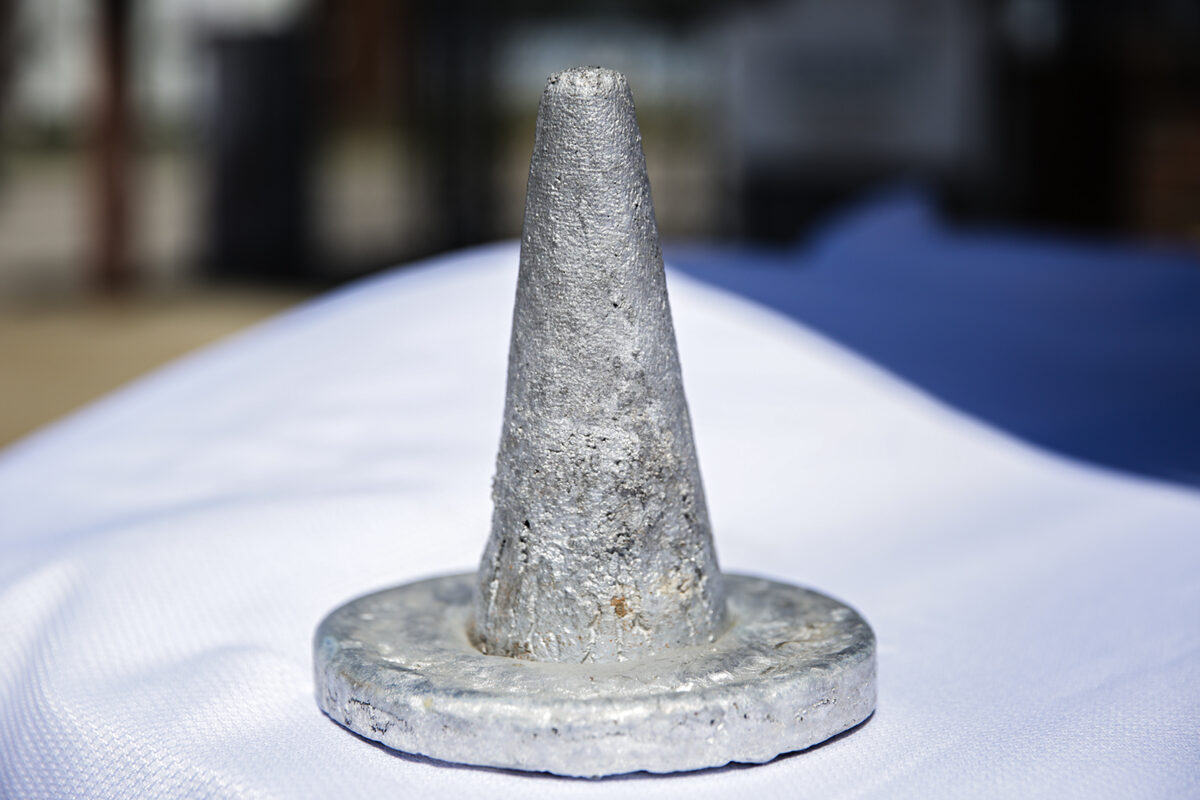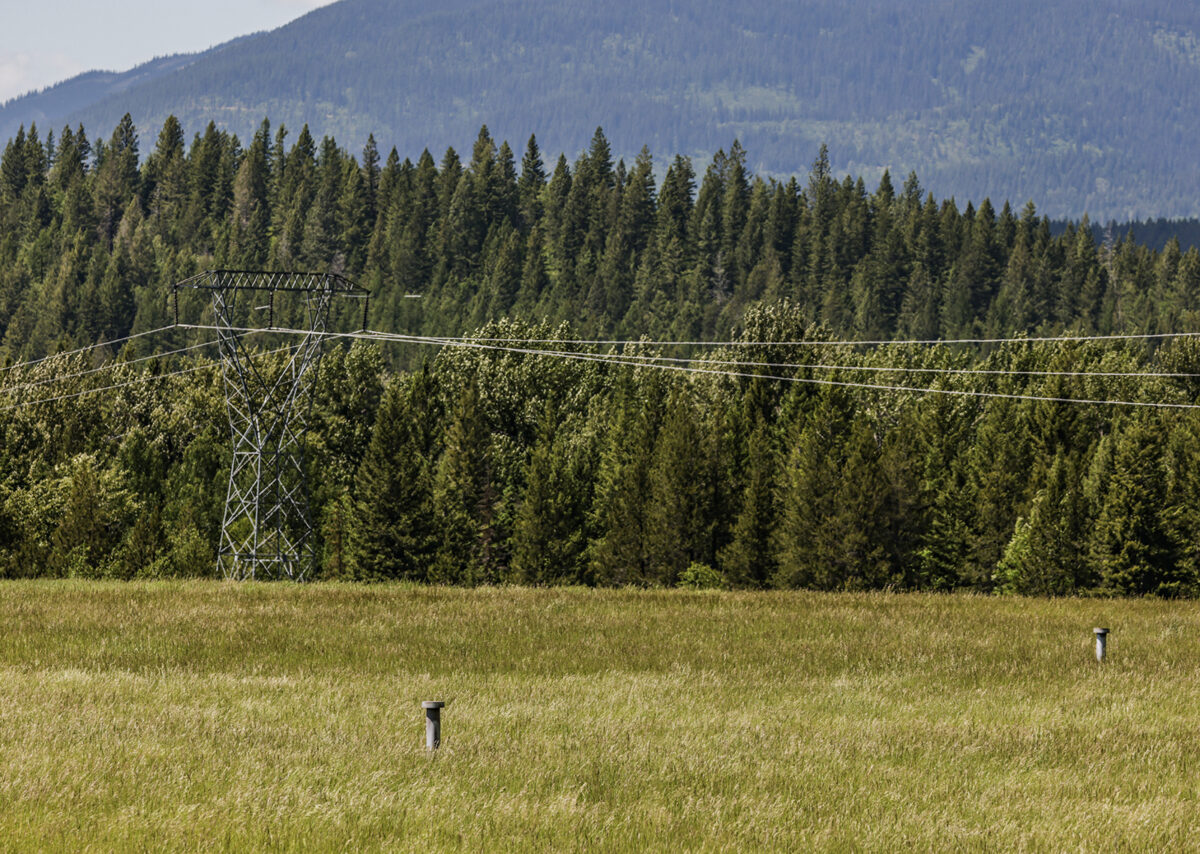CFAC, EPA Detail Proposed Cleanup Plan at Community Superfund Site Tour
With public interest at the contaminated site intensifying due to emerging development plans, environmental regulators and company officials have launched new outreach efforts
By Tristan Scott
From a prominence near the base of Teakettle Mountain, along the northern edge of the Columbia Falls Aluminum Company (CFAC) property, a lumpy, low-slung field stretches south for nearly a mile to the Flathead River. For visitors standing at that overlook today, it’s hard to imagine that a hub of industry once occupied the 2,400-acre parcel sprawled out in front of them; or that it once accommodated Montana’s largest covered building, which stood at 1,750,000 square feet and spanned 40 acres; or that, at the height of productivity, 2,000 workers produced 185,000 tons of aluminum annually.
For visitors to the rubble-strewn property, which is framed by Badrock Canyon, with Glacier National Park providing a scenic backdrop, it’s hard to imagine that plans are underway to redevelop and repurpose the threadbare manufacturing site at their feet, transforming it back into a bustling center of commercial and industrial activity flanked by new neighborhoods and new single-family homes. It’s harder still to imagine that a hotspot of toxic contamination lies beneath them, leaching into soils that should no longer be touched and groundwater that should no longer be tapped.
But for the state and federal environmental regulators who have spent the past decade probing the soil and sampling the groundwater beneath the rolling flood plain to understand the extent of the contamination, it’s less of a mystery and more of a problem in search of a solution.
That solution has slowly been taking shape in the form of a proposed remediation plan, which was crafted by environmental engineers hired by CFAC and is being overseen by regulators with the U.S. Environmental Protection Agency (EPA) and Montana Department of Environmental Quality (DEQ). If the plan is approved and everything goes as expected, a set of benchmarks established to ensure that environmental standards and human health and safety objectives are met — criteria that a feasibility study refers to as preliminary remedial goals (PRGs) — could be achieved in four years.
With one major exception.
The lumpy field under the visitors’ feet is known as Decision Unit 1 (DU1), and it’s the central focus of a federal Superfund designation comprising the former CFAC plant’s west landfill and its wet scrubber sludge pond, where experts have pinpointed the highest concentrations of contaminants. Most concerning, experts say, is that the groundwater plume underneath the unit is laced with poisonous amounts of cyanide, arsenic and fluoride, which are the byproducts of the aluminum smelting process that occurred for more than a half-century. That process began by dissolving aluminum oxide in a bath of molten cryolite, which was contained inside brick-lined cells, or pots. The bricks were used to insulate the pots from the temperature conversion process and, when they failed, needed to be disposed of and replaced.

“In the old days, they used to remove the bricks and bring them up to this landfill and just dump the bricks in the ground,” CFAC Project Manager John Stroiazzo said last week on a tour of the property. “Well, we discovered after some time that the cyanide and fluoride that was contained in the bricks started to leach out and contaminate the groundwater, so that led to some groundwater contamination which is the issue now at Columbia Falls Aluminum. It is pretty much the central focus point of the environmental remediation work that is going to be conducted on the site.”
So, while the PRGs across most of the site will be achieved within four years, the PRGs at the west landfill and wet scrubber sludge pond, which environmental regulators have designated as DU1, will take longer; between 14 and 26 years.
“During this period, EPA’s preferred remedy includes deed restrictions to prevent drinking of impacted groundwater,” according to EPA’s proposed cleanup plan. “In addition, EPA’s preferred remedy includes groundwater monitoring to measure the progress of the remediation on an ongoing basis until PRGs are achieved.”
Even though the landfills are capped, they have been releasing contaminants into the groundwater whenever seasonal high-water levels touch the buried waste, migrating toward the Flathead River, where concentrations of metals in the seeps along the river are relatively low. While some DEQ standards for aquatic life are exceeded, “there is no contamination above background values in the Flathead River,” according to Matt Dorrington, the EPA’s remedial project manager for the CFAC Superfund site.
Dorrington said the toxicity of the contaminants in the groundwater plume degrades as they migrate toward the river so that, even without treatment, they are below the state’s standards for human health.
“But they still exceed aquatic life toxicity criteria. That’s what’s driving the need for the cleanup,” he said.

Dorrington said there have been no documented impacts to fish or other aquatic organisms, and water quality in the river meets state and federal standards. The feasibility study’s analysis shows that the proposed remedy will reduce concentrations to acceptable levels in the seeps without removing the landfilled wastes, but the cleanup plan still calls for constructing a semi-fluid sub-surface barrier around DU1 to contain the waste. Called a slurry wall, the barrier would stretch 3,000 to 4,000 feet in length, wrapping around the perimeter of DU1 and filling a trench 120 feet deep before tying into the aquitard, a geologic formation with a low rate of permeability that would form the fourth wall of a containment cell designed to hold the reservoir of contaminated groundwater at the source.
“That’s the key right there. Where the slurry wall ties in with the aquitard,” Dorrington said. “But even if it fails; even if there were cracks or fissures, it wouldn’t be like a dam breach, and there would be backup protocol in place.”
That backup protocol includes installing eight pairs of extraction/monitoring wells (one within and one outside of the slurry wall) downgradient of the wet scrubber sludge pond, with another series of monitoring wells downgradient of the slurry wall. The remediation plan also calls for constructing a groundwater treatment facility.
“All of our experts are quite confident that this will work quite well,” Stroiazzo said.
The advice of technical environmental experts doesn’t always reach or resonate with every segment of the Columbia Falls community, however. And in the two months since Glencore, the Swiss commodities giant that owns CFAC, publicly announced plans to sell the property to high-profile local developer Mick Ruis for residential and commercial use, some segments of the community have demanded a clearer explanation for how agency officials arrived at the proposed plan to contain, rather than remove, the waste.

While the terms of the sale are confidential, the deal is contingent on EPA finalizing the details of its proposed cleanup plan by issuing a Record of Decision (ROD).
If EPA issues a ROD that is materially different than the preferred alternative agencies have selected, “CFAC will need to evaluate that plan” before proceeding with the sale, Stroiazzo said.
“The overall sale of property including the configuration of the parcels and when they will be sold have been carefully structured so that CFAC can do what needs to be done to remediate the site and EPA and MDEQ have the ability to access the site to supervise that remediation,” Stroiazzo said. “This structure was based on the only available plan for site remediation, the EPA’s proposed plan.”

Much of the renewed community concern has centered on the EPA’s proposal to contain rather than remove the environmental hazards; specifically, groundwater in the plume core that contain concentrations of cyanide, fluoride and arcenic in dangerous concentrations, posing risk to future residential drinking water users.
The EPA did evaluate the cost of off-site disposal, estimating it as ranging from $625 million to $1.4 billion, compared to the $57.5 million cost of the preferred alternative. The agency also evaluated the logistics of off-site disposal, including excavating about 1.2 million cubic yards of hazardous waste from the landfills, which would need to be dewatered and carted off site to the nearest Resource Conservation and Recovery Act (RCRA) landfill in Arlington, Ore., nearly 500 miles away. The process would require 60,000 truckloads or rail containers passing through 30 neighboring communities on the way to the Oregon landfill, including Spokane, Wash., and the Tri-Cities, amounting to 70 trucks or trains per day over the course of four or five years “with associated noise, dust, congestion, traffic issues, and delays from railroad crossings.”
And that’s without considering the health risks to workers loading and unloading trucks with spent potlining — the waste generated at an aluminum smelting facility such as CFAC, and which can react with water to produce toxic and explosive gases — let alone the potential traffic accidents and fatalities likely to occur based on Federal Highway Administration statistics.
“There are serious risks associated with off-site disposal,” Dorrington said. “Now, are they risks that we can mitigate? Sure. But I wouldn’t want my son working on that site.”
Bev York, whose husband worked at the plant in the 1960s, and who served on the CFAC Community Liaison Panel created in 2015, said she wasn’t caught off guard by the EPA’s preferred remediation plan to contain the waste because she’s been participating in the public process.
“They’re doing everything they can to be thorough and transparent about this cleanup and do it legally,” York said. “They’re crossing all their T’s and dotting all their I’s.”

Laura Damon, of Columbia Falls, said she still has lingering concerns about the proposed cleanup plan, in part because she spent her career working in the hard rock mining industry and is familiar with its legacy of pollution.
“My concern is that this plan calls for putting a bucket over the contamination and hoping that the bottom of the bucket doesn’t leak,” she said. “I’d just like to see more data that assures us that’s not going to happen.”